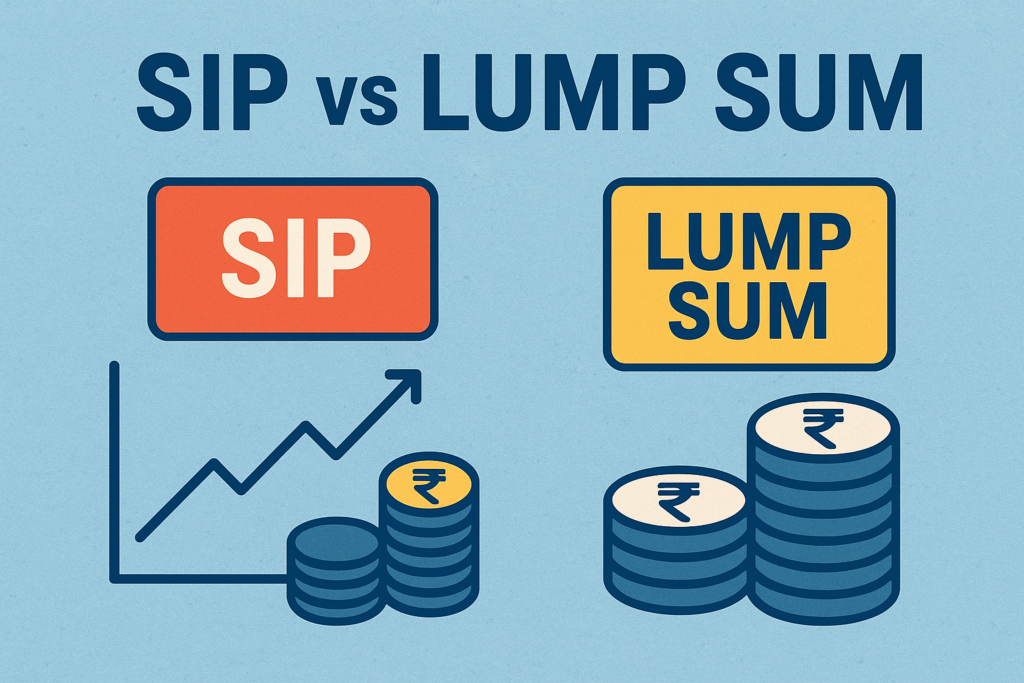Investing in mutual funds has become one of the most preferred ways to build long-term wealth in India. But the biggest confusion for most investors remains the same:
“Should I invest through SIP or Lump Sum? Which method gives better returns?”
Both SIP (Systematic Investment Plan) and Lump Sum investing are powerful wealth-building strategies, but they work differently and suit different types of investors. In this article, we’ll compare them in depth, with examples, tables, advantages, risks, and the best choice for different market conditions.
⭐ What is SIP?
SIP (Systematic Investment Plan) means investing a fixed amount at regular intervals — weekly, monthly, or quarterly.
It is similar to saving money in a recurring deposit, but here you invest in mutual funds.
How SIP Works
- You invest ₹1,000/₹5,000 every month
- Units are purchased based on market NAV
- When markets fall → you get more units
- When markets rise → your portfolio grows
- Over time, it averages out market volatility
This process is called Rupee Cost Averaging.
⭐ What is Lump Sum Investment?
In Lump Sum, you invest a large amount at once, such as ₹50,000 or ₹1,00,000 or ₹5,00,000.
How Lump Sum Works
- You buy mutual fund units at the NAV of that day
- Your returns depend heavily on market timing
- Best suited when markets are low
If you invest at market peaks, returns may drop.
⭐ SIP vs Lump Sum: Quick Comparison Table
| Factor | SIP | Lump Sum |
|---|---|---|
| Investment Style | Monthly/regular | One-time |
| Best For | Salaried & beginners | Experienced investors |
| Market Timing Required | No | Yes |
| Risk Level | Low to moderate | Higher |
| Average Cost Benefit | Yes (rupee cost averaging) | No |
| Ideal Market Condition | Volatile/uncertain | Falling market |
| Returns Potential | Stable long-term | Higher if timed well |
⭐ Example: SIP vs Lump Sum Returns (5 Years)
Assume a mutual fund gives 12% annual return.
If you invest ₹5,000 per month (SIP):
- Total investment: ₹3,00,000
- Approx. value in 5 years: ₹3,97,000
If you invest ₹3,00,000 at once (Lump Sum):
- Value in 5 years at 12% CAGR: ₹5,28,000
📌 Conclusion:
If the market grows steadily, lump sum gives higher returns.
But if markets fluctuate, SIP gives safer, more stable returns.
⭐ Benefits of SIP
✔ 1. Reduces Market Risk
Because you invest regularly, market ups and downs get averaged out.
✔ 2. Perfect For Salaried People
You don’t need to wait for huge savings; even ₹500/month is enough.
✔ 3. Builds Financial Discipline
SIP encourages long-term investing and prevents emotional decisions.
✔ 4. Works Best in Volatile Markets
More units are bought when markets fall → higher long-term gains.
⭐ Benefits of Lump Sum Investing
✔ 1. Higher Return Potential
If you invest when markets are low, returns can be significantly higher.
✔ 2. Ideal for Bonus, PF, Inheritance Money
You can deploy large amounts for long-term wealth.
✔ 3. Compounding Starts Immediately
Since the entire amount is invested at once, compounding works faster.
⭐ Risks of SIP
- Returns can be slow in rising markets
- Requires consistent income
- Not ideal for very short-term goals
⭐ Risks of Lump Sum
- High market timing risk
- If invested during a market peak, returns may fall
- Psychological stress due to volatility
⭐ SIP vs Lump Sum: Which Gives Better Returns?
✔ When SIP Gives Better Returns
- When market is volatile
- When markets crash multiple times
- When you don’t have a large amount to invest
- When you want stable long-term growth
✔ When Lump Sum Gives Better Returns
- When the market is strong and growing
- When you invest during a market dip
- When you are an experienced investor
- When you have long-term goals (5–10 years or more)
⭐ Which Method Should YOU Choose?
If you are a beginner → Choose SIP
Safe, stable, disciplined.
If you receive sudden large money → Choose Lump Sum (with caution)
If markets are high, invest using STP (Systematic Transfer Plan) instead of full lump sum.
If your goal is long-term (5+ yrs) → SIP is better
It smoothens volatility and grows reliably.
If the market is low (market crash/dip) → Lump Sum wins
High return potential after market recovery.
⭐ Hybrid Strategy: SIP + Lump Sum
Many experts recommend a combination:
- Use SIP for monthly investing
- Use Lump Sum whenever market dips 5–10%
This gives the best of both worlds.
⭐ Final Verdict: SIP vs Lump Sum
| Scenario | Best Method |
|---|---|
| Regular income | SIP |
| Market at an all-time low | Lump Sum |
| Beginner investor | SIP |
| Experienced investor | Either |
| Long-term wealth building | SIP |
| Sudden large money (bonus/PF) | Lump Sum or STP |
| High market volatility | SIP |
📌 Overall Winner for Most Investors: SIP
Because:
- Lower risk
- No timing needed
- Best for long-term wealth
- Perfect for Indian salaried individuals
⭐ FAQs: SIP vs Lump Sum
1. Is SIP safer than Lump Sum?
Yes. SIP distributes risk by investing over time.
2. Can I convert Lump Sum into SIP?
Yes, using STP (Systematic Transfer Plan).
3. Which gives higher returns?
Lump Sum can give higher returns if invested at the right time, but SIP gives more stable returns for long-term investors.
4. How long should I continue SIP?
At least 5–10 years to enjoy compounding benefits.
5. Can I stop SIP anytime?
Yes. SIPs are fully flexible — you can pause or stop anytime.
✅ FAQs: SIP vs Lump Sum
1. What is the main difference between SIP and Lump Sum?
SIP involves investing a fixed amount regularly (monthly/weekly), whereas Lump Sum is a one-time investment of a large amount at once.
2. Which gives better returns: SIP or Lump Sum?
Lump Sum can give better returns if invested during a market dip, but SIP generally provides more stable returns over the long term because it averages out market volatility.
3. Is SIP better for beginners?
Yes. SIP is ideal for beginners and salaried individuals because you don’t need market timing or a large amount to start.
4. Should I invest Lump Sum when the market is high?
No. Investing Lump Sum at market peaks increases risk. Instead, use STP (Systematic Transfer Plan) or wait for corrections.
5. Can I do SIP and Lump Sum together?
Yes. A hybrid strategy works best — monthly SIP for consistency + Lump Sum during market dips.
6. Is SIP safe during market crashes?
Yes. SIP is actually more effective during crashes because you acquire more units at lower prices, improving long-term returns.
7. How long should I continue SIP for best returns?
At least 5–10 years to maximize compounding and reduce the impact of market volatility.
8. Can I pause or stop my SIP anytime?
Yes. SIPs are flexible. You can pause, modify, or stop them anytime without penalty.
9. Does Lump Sum investment require market timing?
Yes. Lump Sum returns depend heavily on the market level at the time of investment.
10. Which is better for long-term goals like retirement?
SIP is generally better for long-term goals because it offers disciplined investing and stable growth.
11. What is a good amount to start SIP?
You can start with as little as ₹500 per month. The key is consistency, not the amount.
12. Is Lump Sum good for investing bonus or PF money?
Yes, but only if the market is favourable. Otherwise, invest using STP to reduce timing risk.
13. Can SIP give higher returns than Lump Sum?
Yes, in highly volatile markets SIP can outperform Lump Sum by averaging the purchase cost.
14. Does SIP guarantee returns?
No. SIP does not guarantee returns, but it reduces risk through cost averaging and compounding.
15. What is the best time to invest Lump Sum?
The best time is during market dips, corrections, or when valuations are low.



